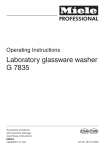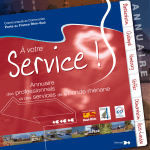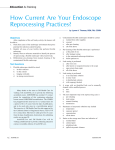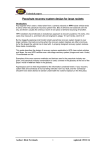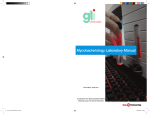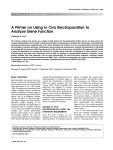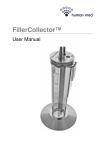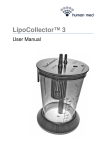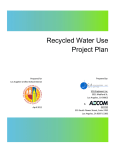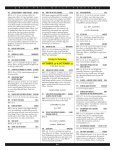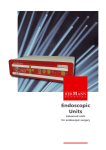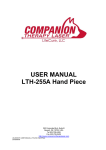Download Medical College of Virginia Hospitals of Virginia Commonwealth
Transcript
Medical College of Virginia Hospitals of Virginia Commonwealth University MCV Physicians Sterilization and Disinfection The contents herein reflect policies and procedures in accordance with local, state and federal regulating agencies regarding the practices of disinfection and sterilization of equipment used in the care of patients. The MCV organization has developed these guidelines for education, information and use within its facilities, and reflect the standards necessary to perform these procedures. The contents are reviewed at least annually and updates as changes are made by local, state and federal regulating agencies. The statements reflect the most recent regulations by the City of Richmond, state and federal Occupational Safety and Health Administration, the Environmental Protection Agency, the Food and Drug Administration, as well as recommendations by AORN, HICPAC, ASA, AANA, and ASGE. __________________________________ Hospital Epidemiologist ____________ Date __________________________________ Chair, Infection Control Committee ____________ Date __________________________________ Director, Materials Management ____________ Date __________________________________ Supervisor, Central Sterile Supply ____________ Date 1 Virginia Commonwealth University Health System Medical College of Virginia Hospitals and Physicians Infection Control Subject: Sterilization and Disinfection I. Policy No: 3105.01 Original Date: 1996 Revised Date: 1999 Reviewed Date: 3/03 Introduction One of the key elements in limiting the spread of hospital-associated infections or blood-borne pathogens among patients is an effective sterilization and disinfection policy. The policies herein are based upon the most recent Hospital Infection Control Practices Advisory Counsel (HICPAC), and Centers for Disease Control and Prevention (CDC) recommendations and guidelines. They also comply with the most recent Food and Drug Administration (FDA), Occupational Safety and Health Agency (OSHA) and Environmental Protection Agency (EPA) regulations regarding the handling of cleaning, disinfecting and sterilizing agents. The policies herein apply to the Virginia Commonwealth University Medical College of Virginia Campus Hospitals and Clinics, the MCV Associated Physicians Clinics, and all outlying medical facilities affiliated with MCV or MCVAP. The specific monitoring of these outlying institutions is outlined in detail in specific sections. II. Definitions A. Sterilization: The complete elimination or destruction of all forms of microbial life. This is accomplished by either physical or chemical processes, which include: steam under pressure; dry heat; low temperature sterilization (ethylene oxide [ETO], plasma sterilization); and liquid chemicals. B. Disinfection: A process that eliminates many or all pathogenic microorganisms, with the exception of bacterial spore’s from inanimate objects. This is generally accomplished by the use of liquid chemicals or wet pasteurization. For clinical settings, disinfection is broken down into 3 categories: 1. High-level: Expected to destroy all microorganisms, with the exception of high numbers of bacterial spores. 2. Intermediate-level: Inactivates M. tuberculosis, vegetative bacteria, most viruses, and most fungi. It does not necessarily kill bacterial spore. 3. Low-level: Kills most bacteria, some viruses, and some fungi, but it cannot be relied upon to kill resistant microorganisms such as MTB, or bacterial spores. C. Cleaning: The removal of all foreign material such as soil and organic material from objects. This is accomplished with water, mechanical actions, and detergents or enzymatic products. Failure to properly clean an object will render all disinfection or sterilization processes ineffective. D. Patient Care Items: Items and instruments for patient care are divided into 3 categories: 1. Critical: Items assigned to this category present a high risk of infection if contaminated with any microorganism, including bacterial spores. It is critical that these objects be kept sterile. Instruments include surgical instruments, 2 2. 3. cardiac and urinary catheters, implants and needles. Most items must be steam sterilized if heat labile, then the object may be treated with ETO or other low-temperature sterilization process. Chemical sterilants may also be used, and include: 2% glutaraldehyde-based formula 6% stabilized hydrogen peroxide peracetic acid These MUST be FDA cleared and have received 510(K) clearance. Semicritical: that object that come in contact with mucous membranes or skin that is not intact. These items must be free of all microorganisms, with the exception of low numbers of bacterial spores. Items in this category include respiratory therapy and anesthesia equipment, endoscopes, and cervical diaphragm fitting rings. These items require high-level disinfection with wet pasteurization or chemical disinfectants. Chemical sterilants include: 2% glutaraldehyde 6% stabilized hydrogen peroxide chlorine (1000 ppm) peracetic acid Heat sterilization is the preferred method of between patient’s processing of heat-stable instruments. Sterile water and not tap water is used to rinse these instruments following chemical disinfection. Tap water has conveyed various microorganisms, including non-tuberculosis mycobacterium, and Legionella. If sterile water is not available, then tap water rinse followed by a 70% ETOH rinse followed by forced-air drying is performed. Non-critical: These are items that come in contact with intact skin but not with mucous membranes or nonintact skin. Items in this category include bedpans, blood pressure cuffs, bedside tables, bed rails, crutches, linens, and some food utensils. Most of these items may be disinfected where they are used. Low-level disinfectants include: ethyl or isopropyl alcohol (70-90%) sodium hypochlorite (5.2% household bleach) 1:500 dilution (100 ppm free chlorine) Phenolic germicidal detergent solution* Iodophor germicidal detergent solution* Quaternary ammonium germicidal detergent solution* *per manufacturer’s recommended utilized dilutions E. Standard Precautions: All patient care items should be considered contaminated with blood-borne pathogens, including HIV, HCV, and HBV. No specific designation will be made regarding medical equipment used in the care for patients infected with these pathogens. Standard sterilization and disinfection procedures for patient care equipment are adequate to sterilize or disinfect instruments or devices contaminated with blood or other body fluids from persons infected with blood-borne pathogens, including HIV. No changes in cleaning, disinfection or sterilization procedures need to be made. F. Patient Care Areas: Noncritical environmental surfaces contaminated with large amounts of blood or body fluids (<30cc) shall be cleaned and followed by disinfection with a fresh 0.5% sodium hypochlorite solution (1 part bleach to 9 parts water). If chlorine is corrosive to the surface, then a phenol agent may be used (see manufacturer instructions). Gloves and appropriate personal protective equipment (including fluid resistant gown if needed) shall be worn during the clean up. G. Selection and use of disinfectants: changes in disinfectants and chemical agents must be made after consulting with the hospital epidemiologist. No other person or person may approve the change. 3 H. System Monitoring: All high-level disinfection and sterilization practices whether in MCV Hospitals or clinics will comply with these measures. Changes in practice procedures will be submitted to the supervisor of CSS and the Hospital Epidemiologist for approval by them, the Infection Control Committee, and the administrative body. The clinic or facility performing these procedures will identify a person or persons responsible for performing these duties. That person(s) will attend a training session designed by the supervisor of CSS to ensure proper training in cleaning and disinfection technique, the use of protective gear, recall protocols, and emergency response should a chemical spill or splatter occur. The identified person will maintain original records of the above at the clinic or facility, and provide a monthly report to the supervisor of CSS. The reports will be summarized on a quarterly basis at the Infection Control Committee meetings, and the summary will become a quality improvement document. Any identified breaches, contamination problems, or recalls will immediately be called in to the supervisor of CSS and to the Epidemiology Unit so appropriate measures can be taken. 4 REFERENCES 1. Rutala WA. Disinfection, sterilization and waste disposal. In: Wenzel RP ed. Prevention and control of nosocomial infections. 2nd ed. Baltimore: Williams and Wilkins, 1993:460-95. 2. Rutala WA. APIC guidelines for selection and use of disinfectants. Am, J Infect Control 1996;24:313-42. 3. Garner JS, Favero MS. Guidelines for handwashing and hospital environment control. Am J Infect Control 1986;14:110-26. 4. Rutala WA. APIC guidelines for selection and use of disinfects. Am J Infect Control 1990; 18:99-117. 5. Food and Drug Administration, Public Health Service, understanding between the Food and Drug Administration, Public Health Service and the Environmental Protection Agency. Washington DC: FDA, PHS, EPA June 1993. 6. Rutala WA, Clontz EP, Weber DJ, Hoffman KK. Disinfection practices for endoscopes and other semicritical items. Infect Control Hosp Epidemiol 1991;12:282-8. 7. Martin MA, Reichelderfer M. APIC guidelines for infection prevention and control of flexible endoscopy. Am J Infect Control 1994;22:19-38. 8. American Dental Association. Infection control recommendations for the dental office and the dental laboratory. J Am Dent Assoc 1992;123:1-8. 9. Centers for Disease Control and Prevention. Recommended infection control practices for dentistry, 1993. MMWR 1993;41(RR-8):1-12. 10. Department of Health and Human Services, Food and Drug Administration. Dental Handpiece sterilization. Washington DC: FDA, September 28, 1992. 11. Favero MS, Pugliese G. Infections transmitted by endoscopy; an international problem. Am J Infect Control 1996;24:343-5. 12. Gurevich I, Jacobsen E, Cuhna BA. Unreliability of chemical integrators compared to spore tests for sterilizer monitoring. Am J Infect Control 1996;24:405-6. 5 CLEANING AND HIGH-LEVEL DISINFECTION: CRITICAL PATIENT CARE ITEMS I. PURPOSE To describe and establish guidelines for the cleaning and disinfection of critical patient care items. II. POLICY All medical/surgical patient care items that are used for diagnostic or therapeutic interventions and come in contact with otherwise sterile body spaces must be cleaned and disinfected to a high-level between patients. III. PROCEDURES A. Cleaning, disinfecting and sterilizing patient care equipment: all objects to be highlevel disinfected or sterilized should first be thoroughly cleaned to remove all organic matter and debris (blood, tissue, etc.) and other residue. 1. Critical medical devices or pieces of patient care equipment that enter normally sterile tissues or the vascular system or through which blood flows will be sterilized before each use. 2. Laparoscopes and arthroscopes: Laparoscopes, arthroscopes, and other scopes that enter normally sterile tissue should be subjected to a sterilization procedure before each use. If this is not feasible, they should receive at least high-level disinfection followed by rinse with sterile water. 3. Equipment that touches mucous membranes such as endotracheal tubes, anesthesia breathing circuits and respiratory therapy equipment should receive high-level disinfection. B. Chemical methods for sterilization: 1. When sterilization is indicated and other sterilization methods such as steam or ETO cannot be used, a hospital approved liquid chemical sterilant may be used. The manufacturer’s instructions for use will specify the recommended exposure time. 2. The selection and use of disinfectants: Changes in disinfectants and chemical agents may only be made following consultation with the Hospital Epidemiologist. No other person or persons may approve these changes. C. System monitoring: All high-level disinfection practices whether in MCV Hospitals or MCV clinics, will comply with these measures. Changes in practice procedures will be submitted to the supervisor of CSS and the Hospital Epidemiologist. Any change will be approved by them, the Infection Control Committee, and the administrative body. The clinic or facility performing these procedures will maintain a log of these practices. The clinic or facility performing these procedures will identify a person or persons responsible for performing these duties. That person(s) will attend a training session designed by the supervisor of CSS to ensure proper training in cleaning and disinfection technique, the use of protective gear, recall protocols, and emergency response should a chemical spill or splatter occur. The identified person will maintain original records of the above at the clinic or facility, and provide a monthly report to the supervisor of CSS. The reports will be summarized on a quarterly basis at the Infection Control Committee meeting and the summary will become a quality improvement document. Any identified breaches, contamination problems, or recalls will immediately be called in to the supervisor of CSS and to the Epidemiology Unit so appropriate measures can be taken. 6 CLEANING AND HIGH-LEVEL DISINFECTION: SEMICRITICAL CARE ITEMS I. PURPOSE To describe and establish guidelines for the cleaning and disinfection of semi-critical patient care items. II. POLICY All medical/surgical patient care items that are used for diagnostic or therapeutic interventions and come in contact with mucous membranes or non-intact skin must be cleaned and followed by high-level disinfection between patients. III. PROCEDURE A. Selection and use of high-level disinfectants 1. Solutions containing glutaraldehyde, hydrogen peroxide, chlorine and peracetic acid can achieve high-level disinfection if objects are properly cleaned before disinfection. The disinfectant or chemical sterilant should have no or minimal deleterious effects on the object. 2. Duration of dwell should be according to manufactures recommendations at room temperature (20°C) following cleaning. B. Special Instruments 1. Tonometers, diaphragm fitting rings: a. Wiped clean b. Disinfect: 5-10 minute soak in 6% stabilized hydrogen peroxide, 0.5% sodium hypochlorite (1 part bleach with 9 parts water made fresh), 70% ethyl alcohol (7 parts high-grade ethyl alcohol: 3 parts sterile water, made fresh), or 70% isopropyl alcohol (similar proportions). c. Rinse: Rinse thoroughly with tap water d. Dry: allow to air dry 2. Cryosurgical equipment: These items, while categorized as semi-critical, should receive high-level disinfection or sterilization regardless of the use of a condom with use. 3. Endoscopes: This category includes all endoscopes for GI procedures, transesophageal echocardioscopes, and bronchoscopes. Cleaning and disinfection involves 6 steps: a. Clean-mechanically clean external surfaces, ports, and internal channels with water and a detergent or enzymatic detergent. b. Rinse-thoroughly rinse and drain channels c. Disinfect-immerse the endoscope in high-level disinfectant and perfuse the disinfectant into the suction/biopsy channels and air and water channels, exposing for at least a 20-minute dwell at 20°C. d. Rinse-thoroughly rinse the endoscope and channels with sterile water. Tap water may be used, but must be followed by an ETOH rinse and forced air dry. e. Dry-the insertion tube and inner channels should be dried by means of forced air after disinfection and before storage. f. Store-the endoscope should be stored in a way that prevents recontamination. g. Brushes-the brushes used to clean the endoscope channels should be soaked in glutaraldehyde overnight, and in glutaraldehyde or an enzymatic agent between uses during the day. 4. All other equipment (i.e., laryngoscope blades, etc.): 7 a. b. c. 5. C. should be soaked in an enzymatic solution High level disinfection per policy ETO sterilization 1. Wipe enzymatic solution 2. Rinse with tap water 3. ETO sterilize Endoscopes accessories: Biopsy forceps or other cutting instruments that break the mucousal barrier shall be sterilized. Other Endoscope accessories such as suction valves should be sterilized following each use, if not feasible, then high-level disinfection is required. System monitoring All high-level disinfection practices whether in MCV Hospitals or MCV clinics, will comply with these measures. Changes in practice procedures will be submitted to the supervisor of CSS and the Hospital Epidemiologist and they, the Infection Control Committee, and the administrative body will approve any changes. The clinic or facility performing these procedures will maintain a log of these practices. The clinic or facility performing these procedures will identify a person or persons responsible for performing these duties. That person(s) will attend a training session designed by the supervisor of CSS or, designated person, to ensure proper training in cleaning and disinfection technique, the use of protective gear, recall protocols, and emergency response should a chemical spill or splatter occur. The identified person will maintain original records of the above at the clinic or facility, and provide a monthly report to the supervisor of CSS. The reports will be summarized on a quarterly basis to the Infection Control Committee, and the summary will become a quality improvement document. Any identified breaches, contamination problems, or recalls will immediately be called in to the supervisor of CSS and to the Epidemiology Unit so appropriate measures can be taken. 8 CLEANING, HIGH-LEVEL DISINFECTION AND STERILIZATION: DENTAL INSTRUMENTS I. PURPOSE To describe and establish guidelines for the cleaning, disinfection and sterilization of critical and semi-critical dental patient care items. II. POLICY All dental patient care items that are used for diagnostic or therapeutic interventions are treated as critical or semi-critical and receive high-level and/or sterilization between patient use. A. Critical Instruments The instruments that normally penetrate soft tissue or bone, e.g., forceps, scalpels, bone chisels, scalers, and surgical burs are considered critical and must be sterilized or discarded following each use. B. Semicritical Instruments Instruments that are not intended to penetrate oral soft tissues or bone, e.g., amalgam condensers, air/water syringes, but may come in contact with oral tissues are classified as semicritical and should be sterilized after each use (JADA 1992:30; 4016; MMWR 1993:41(RR-8) 1-12. 1. If the sterilization process could damage the instrument, the instrument should be high-level disinfected. C. Uncovered operatory surfaces Equipment such as countertops, chair switches and light handles should be disinfected between patients. This may be accomplished using a “hospital disinfectant”, including chemicals such as a quaternary ammonium or phenols. Waterproof disposable surface covers may be used on surfaces that are harmed by these agents between patients. 9 CLEANING AND DISINFECTION NON-CRITICAL PATIENT CARE ITEMS I. PURPOSE To describe and establish guidelines for the cleaning and disinfection of non-critical patient care items. II. POLICY All medical/surgical patient care surfaces that are for diagnostic or therapeutic interventions and come in contact with intact skin but not with mucous membranes or non-intact skin must be cleaned when visibly soiled with blood and/or body fluids. III. PROCEDURE A. Items Items in this category include bedpans, blood pressure cuffs, bedside tables, bed rails, crutches, linens, and some food utensils. Most of these items may be disinfected where they are used. B. Selection and use of low-level disinfectants 1. Solutions for use on noncritical patient care equipment and recommended concentrations include: Isopropyl alcohol (70%) Sodium hypochlorite (0.5%)(1 part bleach to 9 parts water) Phenolic germicidal detergent solution* Iodophor germicidal detergent solution* Quaternary ammonium germicidal detergent solution* 2. The contact time is 30 seconds. 3. Phenolics should not be used to clean infant bassinets and incubators during the stay of an infant. If phenolics are used to terminally clean infant bassinets and incubators, the surfaces must be rinsed thoroughly with water and dried before the items are reused. C. Method of processing reusable transducers: Following cleaning, transducers are sterilized with ETO or disinfected with high-level disinfectant. Transducer heads may also be disinfected with 70% isopropyl alcohol. However, disinfection must be performed rigorously, and in a controlled environment (clean room, not on the patient care unit). The transducers shall be stored in a manner to prevent recontamination before use. *At the manufacturer’s recommended use dilutions 10 PROCESSING CREUTZFELD-JAKOB DISEASE (CJD)-CONTAMINATED PATIENT CARE EQUIPMENT: I. PURPOSE To describe and establish guidelines for the cleaning and disinfection of patient care items that are contaminated by Creutzfeldt-Jakob disease prion. II. POLICY All medical/surgical patients care items that are used for diagnostic or therapeutic interventions and come in contact with patients with CJD. III. PROCEDURES A. This is the only infectious agent requiring unique decontamination recommendations. B. Refer to the Infection Control Manual: CJD policy (#1108.01). 11 PERSONNEL ACCESS TO CENTRAL SERVICE FACILITIES: CENTRAL SERVICE AREAS I. PURPOSE Restrict access of non-Central Service Personnel in all Central Service facilities. See department policy (#001.01) for area classifications and locations. II. POLICY Only persons who have definite need will be allowed access into any Central Service facility. III. PROCEDURE All doors leading into the department from the outside will be kept closed except when utilized for the movement of supplies or equipment. Access restrictions through out the Central Service department are defined below: A. Administrative areas Administrative areas are those areas designated for use by Central Service personnel to perform the administrative functions of the department. These are identified as general and mission-functional areas. 1. General administrative areas: access is unrestricted to any person on official hospital related business 2. Mission-functional areas: access is restricted to hospital and maintenance personnel who perform cleaning, maintenance and equipment inspection activities. B. Work areas Access to the following areas is restricted to housekeeping, maintenance, and personnel who are responsible for scheduled activities within the Unit. The sterile processing supervisor or director of Materials Management must approve the activities and the presence of these personnel. 1. General work area: the general work areas those areas where all work pertinent to Central Sterile Services can be performed except for surgical pack manufacturing. 2. Bulk Storage Areas: the bulk storage areas are those areas where all supplies can be stored without regard for the items’ type of packaging. 3. Sterile Processing/Surgical Pack preparation area: this area is where medical and surgical supplies used for direct patient care are prepared, assembled, packaged and/or wrapped for subsequent sterilization. 4. Clean/Sterile Storage areas: the clean/sterile storage areas are those where medical and surgical supplies directly consumed in patient care are stored. These supplies include sterile and non-sterile (clean) supplies. Items are clearly segregated in this area. 5. Decontamination Area: The decontamination area is the area where soiled reprocessable medical and surgical supplies or equipment are cleaned and prepared for use in the sterile processing section. 12 STERILIZER CONTROL RECALL I. PURPOSE To establish a system by which medical and surgical supply items that received faulty sterilization are recalled, and to identify and follow any patient for whom these items were used may be followed for possible related information. II. POLICY All unused items in a particular sterilization cycle will be recalled for reprocessing or other disposition as deemed appropriate when it has been determined by either chemical or biological monitoring that the required sterilization conditions were not met. The director of Materials Management or the Sterile Processing supervisor is the only people approved to initiate a recall order. III. PROCEDURES A. According the CDC guidelines, objects do not need to be recalled with exception of implantable devices in the event of a SINGLE positive biological indicator UNLESS the sterilizer is found to be defective. Therefore, the supervisor for steam or lowtemperature sterilizers must review all biological indicator results. B. If a positive biological indicator is detected, discontinue use of the presumed malfunctioning sterilizer; notify Epidemiology and the manager or supervisor. C. Once the need for a recall is determined; the immediate supervisor is notified. D. The sterilizer load control data sheets are reviewed to determine the load and units involved in the specific cycle(s). E. Central Supply/Service Requisition records are reviewed to determine in-house or outof-house supplies that require recall. Only items since the last negative biological indicator will be included in the recall. F. Central Supply is notified to hold any recall items that have not been distributed. G. Affected departments are notified with the following information: 1. Type of item(s) 2. Sterilizer number 3. Load control number 4. Method of sterilization H. If linen packs have been involved: 1. Notify the director of the Linen Department for the number of replacement packs needed, 8-413. 2. Notify the Operating Room, Labor and Delivery, or Ambulatory Surgery if linen packs to those specific departments are involved. All unused packs must be collected and returned to CSS, and the unit is provided with the following information: a. Type of item b. Sterilizer number c. Load control number d. Method of sterilization 13 I. All department managers or administrative supervisors of affected areas must be notified in the event that load contents were mixed and could be used universally throughout the hospital or clinics. J. In the event that patients were exposed to improperly sterilized equipment, or that the equipment was used in procedures as part of direct patient care, the department must provide the Epidemiology Unit and the unit’s administrator with the patient’s name, primary physician’s name and the patient medical record number. The Epidemiology Unit is notified in order to follow-up and track the involved patient(s) for 30 days (1 year if an implantable prosthetic device was involved). K. Following notification to users, staff should begin to assist in collecting defective supplies from the environment. L. Items are returned to CSS and reprocessed in accordance to department policies and procedures, or disposed of it appropriate. M. It is the responsibility of the Senior Supervisor of Sterile Processing to document the appropriate information on the recall record and report sheet. All necessary forms are kept in CSS for departmental documentation. The original forms are sent to the Hospital Epidemiology Unit for follow up and tracking. CSS will retain these copies for three (3) years. N. The Plant Operations department will be notified in order to assess and/or correct the sterilizer. 14 ROTATION OF STERILE SUPPLIES I. PURPOSE To establish a standard procedure for stock rotation and to ensure the identification and removal of compromised sterile supplies for patient use circulation. II. POLICY All reusable and disposable medical and surgical supplies will be monitored, inspected and rotated on a daily basis to ensure the integrity of the packaged material. If discrepancies are identified or concern regarding the sterility of the package contents exists, the item will be returned to CSS for either reprocessing if reusable, or for discard if disposable. III. PROCEDURES A. The primary principle to follow is “first in, first out.” This applies for use, rotation, removal and replacement of sterile items in clean utility areas. It is critical that the oldest supplies be issued first. 1. Closed shelving/sterile storage cabinets: supplies are shelved with the sterilization dates plainly visible. Fresh items are placed towards the back bottom and older supplies are moved to the front and top. Supplies are dispensed in a front to back, top to bottom order from the top right corner. 2. Opened shelving/distribution picking aisle: supplies are stocked in bins or on shelves in the picking aisles. Fresh items are placed towards the back bottom and older supplies are moved to the front and top. Supplies are dispensed in a front to back, top to bottom order. 3. Exchange carts: supplies are shelved with the date of sterilization plainly visible. Fresh items are placed towards the back bottom, and older supplies are moved to the front and top. Supplies are dispensed in a front to back, top to bottom order. When more than one shelf is used to stack identical supplies, each shelf must be rotated. When more than one supply item is stacked on a shelf, the freshly sterilized supplies are placed towards the back of the shelf and older supplies rotated forward. 4. Rotation and inspection: The CSS employee must be aware of factors, which can compromise sterility or the barrier efficiency of the packaging material. Some, but not all factors include: dust, moisture, cleansers, breaks in packaging integrity including holes, tears, and broken seals. The CSS personnel must remove items that appear visibly damaged or contaminated from circulation and be returned for reprocessing or disposal. Absolute conditions include: a. All packages that appear soiled, torn, wet or incorrectly sealed are considered contaminated. b. If packaging is inadvertently broken or punctured during transfer or storage, the item is considered contaminated. c. Care will be taken to avoid overcrowding or excessive stacking of sterile items to limit packaging damage and contamination. 5. Disposable Supplies: Manufacturers of sterile disposable items generally claim an indefinite shelf life based on the integrity of the packaging material. If the package is broken, punctured or otherwise damaged, the item is removed from the circulating stock and discarded. Some sterile disposable items have an expiration date. Such supplies include those that contain pharmaceutical supplies or materials such as latex gloves. These supplies must be rotated back to front according to how they are stocked and discarded as indicated by the manufacturer’s expiration date. 15 EXPIRATION OF SUPPLIES I. PURPOSE To provide criteria and guidelines for the duration of sterility of sterilized items. II. III. POLICY A. Sterility of supplies is event related (not time related). This was determined by sterility studies performed at MCV Hospitals and Clinics 4 years ago in which sterility of test items was found to be intact if the integrity of the packaging was not compromised. B. The shelf life of sterile supplies will be determined by the integrity of the pack/packaging unless time-related materials are packaged (biologically degradable materials, pharmaceuticals, latex, etc.). Such items, if packaging remains intact, will be considered sterile until the packaging has been compromised. C. Compromised items are defined as those items whose packaging appears: 1. Wet Dirty Discolored Torn, ripped, mangled or punctured 2. Absent of autoclave tape or the tape is broken Broken Visipak seals Unsealed or has broken locks PROCEDURE A. Hospital Sterile Processing 1. All hospital items processed for sterilization will be properly wrapped in a manner to provide an effective barrier to microorganisms and moisture. 2. All processed hospital supplies will include a lot number and process date, sterilizer and load numbers for recall purposes. 3. All sterile items placed in Visi-peel packs and double wrapped cotton/polyester wrappers will be considered sterile unless the integrity of the packaging has become compromised as described above. B. Independent Manufacturers The shelf life of sterile supplies provided by outside manufacturers will be determined by: 1. The manufacturer’s expiration date 2. The integrity of the packaging material (items will be considered sterile unless the packaging material is compromised as described). 3. Any package that is not used before the expiration date should either be discarded or reprocessed as appropriate. C. Nursing Unit supply areas The user should thoroughly inspect the integrity of all sterile items before use. If the package is torn, wet, punctured or has a broken seal or lock, it is considered contaminated and should not be used. Compromised items should be broken down. The wrapping material should be discarded or if linen returned to a dirty linen cart, and the contents should be returned to CSS for reprocessing. If the item is disposable, then the item should be discarded. 16 CONTAMINATED/SOILED ITEMS: RETRIEVAL ROUNDS I. PURPOSE To develop a standard procedure for collecting and transporting soiled supplies from clinical areas. II. POLICY The CSS will be responsible for retrieving recalled or contaminated or used reusable medical and surgical supplies according to established schedules. III. PROCEDURE Soiled, contaminated, or recalled instruments or other patient care items requiring disinfection and sterilization will be transported in plastic bags designated for contaminated items. The bags are placed on stainless steel carts and covered with a large sheet for protection. It is the nursing staff’s responsibility to remove all disposable needles and scalpel blades before placing any instruments in these bags or bins. The Department representative will fill out the appropriate information on the service requisition prior to CSS retrieval of the soiled items. A. Personnel attire Personnel collecting soiled items must wear a scrub uniform covered with a closed laboratory coat when on retrieval rounds. Gloves must be worn for collection, and must be removed prior to leaving the collection point. Soiled or contaminated clothing must be exchanged immediately. B. Soiled item pickup round Soiled pick up rounds are scheduled for various departments within Main Hospital, North Hospital, West Hospital, and the A. D. Williams Clinic. These are performed daily for the hospitals, and Monday through Friday in the A. D. Williams Clinic. The specific schedule is on Attachment A. C. Special procedures 1. Labor and Delivery: Instruments from L&D will be placed in a decontamination retrieval cart containing covered, stainless steel bins. The items will be transported to the CSS decontamination area. In order to prevent blood from dying on instruments, an enzymatic cleaner solution will be measured per manufacturer recommendations, and placed in the containers holding the retrievable items. 2. Oncology Clinic: The Oncology clinic will use the Central Supply in-house service requisition when requesting supplies to be decontaminated, packaged and sterilized. D. Delivery rounds These are performed on a scheduled basis as well. The CSS personnel and Clinic or Unit representative will both count the supplies to ensure accuracy. The CSS personnel will verify the delivery and count with a signature on the service requisition. The clinic or unit will retain the yellow copy and the white copy is retained by the CSS personnel and maintained in the CSS files. 17 PACKAGING AND WRAPPING PROCEDURES I. PURPOSE To describe standard techniques for packaging and wrapping medical and surgical supplies, and to identify different types of packaging materials used for sterilization. II. POLICY All medical and surgical supplies to be sterilized are packaged and wrapped so that complete and proper sterilization may be achieved and maintained. III. PROCEDURE A. Methods and materials There are 2 approved wrapping methods and one approved prepackaged wrapping method. Strict adherence to limitation guidelines must be achieved to ensure proper penetration of the sterilizing material and to maintain the sterility of the item when circulated to the patient-care areas. Additionally, the size of the packs and instrument trays must be limited to reasonable proportions dictated by the sterilizer carts. 1. Packaging material a. Woven/reusable textile: Is a reusable wrapper that requires laundering, inspection, de-linting, and folding between use. It may be used only for wrapping large linen packs. b. Nonwoven/disposable textile: non-woven wrapping materials are suitable for steam and ethylene oxide sterilization processes. The materials are very permissive to sterilant penetration and are designed for single use. Although these materials are initially moisture repellent and resist wicking of moisture, this barrier breaks down with prolonged exposure to water or detergents. The material has little memory and can be opened aseptically. Nonwoven single-use materials will be used wrapping instrument trays, small linen packs, and individual medical and surgical supply items. c. Polyethylene Tyvek pouches: The polyethylene Tyvek will be used after the sterilization process to provide moisture and dust impervious barrier around trays and other items. In this application, this pouch is used as a dust cover. d. ETO sterilization: Materials that may not be used in packaging items for ethylene oxide sterilization includes: Plastic or Saran wrap Nylon Aluminum foil Polyvinyl Polyester Cellophane 2. Wrapping a. Folds: there are 2 basic folds that are approved for use in Central Sterile Supply. These are the envelope fold and the square fold. 1. The envelope fold wrapping method is used for instrument trays. This is the most convenient fold because each fold provides a single left point, which aids in subsequent aseptic opening of the pack. The procedures are: a. The wrapper is placed diagonal to the work area with one corner pointing to the front of the work area. 18 b. 3. 4. 5. The item is placed in the center of the wrapper at a right angle to an imaginary line drawn from the top and bottom corners. c. The left corner of the wrapper is folded over the item, and then folded back to form a flap. d. The right corner of the wrapped is folded over the item, with the free end tucked into the flap formed by the left corner. A small tab is left visible for easy opening in the sterile equipment. e. The top corner of the wrapper is folded over the item and the flap is tucked into the previous right and left folds, again leaving a small tab visible for easy opening in the sterile environment. f. The second wrapper is applied in the same manner as above, except the excess wrap of the bottom corner is now tucked under. g. The final fold is secured to the outer wrapper with pressure sensitive autoclave tape in accordance with the sterilization method to be employed (steam verses ETO). The pack is labeled to identify the contents, date of sterilization, and load number. Finally, the packer signs the tape. 2. The square fold wrapping method is used to wrap large Operating Room (OR) linen packs. The Linen Department will be responsible for the assembly, wrapping, and delivery of the OR linen packs to CSS for steam sterilization. b. Double wrapping for woven reusable textiles: the first wrap must be sequentially wrapped. The second or outside wrapper is taped to secure the package and labeled. The label includes the item’s name, the load number, and the date of sterilization. c. Dust cover overwrap: To prolong the integrity of the woven or nonwoven wrappers and improve the duration of sterility, packs will be sealed with 3-mil polyethylene Tyvek over wrap pouches following sterilization. Wrapping sizes: Wrapping sizes include the following dimensions in inches: 18 x 18 24 x 24 54 x 54 36 x 36 45 x 45 The wrapper must be large enough to completely enclose the item being packaged and to allow all edges and corners of the wrapper to be securely tucked. Wrappers shall not be drawn too tightly. Limitations a. Reusable/Woven wrappers: packs wrapped in woven materials should not exceed the maximum size of 12x12x20 inches and should not weigh more than 7.2 lbs. b. Instrument trays: these are wrapped as described above. For proper steam penetration, the instrument trays should not exceed 16 lb. Only freshly laundered huck towels and drapes are used when assembling instrument trays. c. Basin sets: all sets are constructed so the smaller basins are positioned in the same direction (all facing down). Basins positioned in different directions will retain water, which will subsequently contaminate the set. Only freshly laundered huck towels and drapes are used when assembling basin sets. Labeling proper labeling is necessary for quality assurance, inventory control and stock rotation. For tape secure packaged wrapped in disposable wrappers, Permanent ink pens are used to record the item description and employee initials. The date of sterilization, and load number are recorded on the labeling sticker (see Monitoring: Load Control Numbers). At no time will information be 19 6. written on the wrapping materials. Additional information including the department to which the item is to be shipped is also written with indelible ink on the autoclave tape. Packaging material shelf left Kim Guard disposable wrapper Sterile unless contaminated Paper/Plastic Pouches Sterile unless contaminated (Heat-sealed Visipaks) 3-mil polyethylene Tyvek wraps Used to provide extra (dust cover over wrap) protection Reusable wrapper Sterile unless contaminated 20 MONITORING: AUTOCLAVE LOAD CONTROL NUMBERS I. PURPOSE To establish appropriate control numbers to facilitate tracking and recall procedures, and to rapidly and easily identify specific items processed in CSS or other alternate site. II. POLICY All medical and surgical supplies sterilized in either disposable or reusable wrappers will be labeled with a load control number. The load control sticker will reflect the sterilizer number, load and cycle numbers, and date of sterilization, item, and employee initials. The load control stickers are placed after the sterilization process is complete, but before a plastic dust cover over wrap is secured. III. PROCEDURE A. Labeling Guns The current standard label gun used in CSS is the System One Model Gun. The gun has an upper section consisting of three (3) bands. Each band contains the numbers 0-9, which are used for setting the load numbers. The gun also has a lower section, which will be used to indicate the sterilization date. Refer to the user’s manual for loading and troubleshooting. 1. Sterilize numbers a. The steam sterilizers in CSS are numbered 2,3, 4, and 5 from left to right when faced. b. The ETO sterilizers are numbered 1 and 6 in the processing area. 2. Load numbers: Each load in each sterilizer will be numbered consecutively beginning with the load number “01” which indicates the first cycle after 7:00 AM each day. 3. Screening: All departments are responsible for screening their sterilized equipment prior to use. Damaged or compromised packaging or exposed items should be removed from circulation and returned to CSS. The CSS personnel are responsible for disassembling reusable packs and reprocessing the items. The contaminated linen will be placed in linen carts for appropriate treatment. 4. Label Color: white labels-used for all event-related supplies. 5. Imprinting: fully squeeze the handle and release. A label will appear at the front of the label gun. Place the front of the gun on the packaged item and apply the label using a downward sweeping motion. Labels will be affixed on products as follows: a. For all reusable and disposable wrappers, place the label on the pressure sensitive tape. Labels must affix so that they are removed when the tape is removed. b. For paper/plastic pouches, place the label on the plastic side only so it may be clearly visible to the customer. c. For polyethylene Tyvek bags, place the label in the most convenient and obvious position for visibility. The labels should not interfere with the proper techniques for opening these packages. 21 MONITORING: CHEMICAL INDICATORS OF STERILIZATION I. PURPOSE To identify and describe the use of chemical indicators to inform the customer that an item had been processed by CSS and subjected to sterilization cycle. II. POLICY Every medical and surgical supply item prepared, assembled, wrapped or packaged, and sterilized by CSS will include an internal and external chemical indicator to identify that the item has been processed through a sterilization cycle. III. PROCEDURE A. Indicators 1. Chemical Controls: These are special chemical substances, which react with paper when specific sterilization conditions are present. 2. Indicators: These are chemo- and thermo- reactive devices, which indicate presence and exposure to steam or ETO but do not indicate sterility. There are two (2) basic forms of chemical indicators used in CSS. a. Internal b. External B. Internal indicators Internal indicators consist of strips lacking gummed backs. These indicators are used inside all items, which are reprocessed in CSS. They are placed in the center of the pack during the wrapping process. In the case of paper or plastic pouches, the indicator strip will be placed inside the pouch and will be plainly visible through the porch. The indicator strips change color under specific conditions: brown when exposed to steam and orange when exposed to ETO gas. C. External indicators Every item sterilized by CSS or alternate sterilization site will have an external chemical indicator affixed to the package. The external indicator used in this organization is gummed-back pressure-sensitive autoclave tape designed for use on the exterior of wrapped packs or pouch packages. The indicator is color-coded: brown indicates exposure to steam; green indicates exposure to ETO gas. 22 MONITORING: BIOLOGICAL TEST PACK, STEAM STERILIZATION I. PURPOSE To define and provide procedures to determine the efficiency and quality assessment of the steam sterilization process. II. POLICY The autoclave should provide complete sterilization of all reusable medical and surgical supplies processed or assembled in the Central Sterile Services department or alternate sites. The steam sterilization process will be monitored routinely at all MCV sites utilizing biological spore testing to identify faulty or inadequate sterilization conditions. Regulations require: Weekly testing for most areas Daily testing for high-use areas (CSS, OR’s) as needed with a run if the sterilizer is used infrequently This policy supersedes all prior policies and applies to all sites under the VCUHS umbrella involved with steam sterilization. III. PROCEDURE/Operating Instructions The A-test biological test packs consist of 2 (two) 20 cc glass vials with a biological indicator vial impregnated with a known number of spores from Bacillus stearothermophilus. The growth medium contains a colorimetric indicator (color change due to pH of the culture media) to demonstrate growth if the sterilization process is not adequate. Bacterial spores are utilized, as these are the most difficult microorganisms to inactivate. A. Control Indicator 1. LABEL the non-sterilized control indicator with the letter C and record the date and time of incubation. 2. ACTIVATE the medium in the control indicator by holding the indicator upright and crushing the ampoule inside the plastic tube. 3. PLACE the control indicator in the appropriate slot in the incubator (see Attachment A). B. Test Indicator The PROOF or test indicator is a biological vial containing a disc of Bacillus stearothermophilus spores. 1. Place two (2) test indicators inside the center of four (4) huck towels and wrap the pack by the envelope fold method. 2. Place the wrapped pack on the bottom of the sterilizer rack. It must be near the door and over the chamber drain strainer. 3. Run the test pack with a routine load through a complete sterilization cycle. 4. Following the completion of the sterilization cycle, open the sterilizer door 6 inches and allow the contents to cool and dry for 20 minutes before removing the test pack. 5. Remove the test indicators from the pack and activate the medium by holding the indicator upright and crushing the ampoule inside the plastic tube. 6. Record the sterilizer number, date, load control number and employee’s initials on the label tape and attach around the indicator cap. 7. Place the test indicators in the appropriate slots in the incubator. 8. At 24 hours, examine the control and test indicators for evidence of bacterial growth. This is indicated by a change in color of the medium from red to yellow. If there is no evidence of growth, record both readings on the Biological Indicator Chart (see Attachment B). For negative results (no growth), circle the minus (-) sign. For positive results (bacterial growth), circle the plus (+) sign. 9. Interpretations a. The control vial MUST have growth at 24 hours 23 b. 10. C. If a positive result is recorded in either of the test indicators, repeat the test procedure and report the findings immediately to the Sterile Processing Supervisor or designee. (Refer to Recall Policy). A recall must be initiated. c. If a negative result is recorded for the Control vial, repeat the testing and inform the supervisor. This may indicate a faulty indicator lot. Dispose of all used indicators in a sharps container. Reporting 1. 2. 3. MCV Hospitals and Clinics Each month, a complete copy of the biological indicator results will be reviewed and kept on file in Central Sterile Services. A copy will be forwarded to the Hospital Epidemiologist or his/her designee. A quarterly report will be provided from CSS to the Infection Control Committee. Alternate Sites All original documentation and records will be maintained on site. A copy of the biological testing report will be forwarded to the Supervisor of CSS at MCV on a weekly basis. The reports are compiled and results are reported by the CSS representative to the Infection Control Committee on a quarterly basis or if a breach is identified. A copy of the quarterly report will be submitted to the Infection Control Committee and to the Hospital Epidemiologist. Recalls All recalls are initiated by CSS. All recalls will be reported to the Infection Control Committee and to the Epidemiology Unit (see Recall Policy). 24 MONITORING: EQUIPMENT, STEAM STERILIZERS I. PURPOSE To describe the monitoring system employed to document the archival of parameters of the steam sterilizer process. II. POLICY All steam sterilizers used within the MCV hospitals and clinics for the purpose of sterilizing patient-care related items would be continually monitored using chemical, mechanical, and biological indicators for the purposes of lot control, quality control and assessment, and tractability. III. PROCEDURES A. Sterilizer types Two (2) types of sterilizers are employed for processing patient care supply items including the steam sterilizer and ETO. The Hi-Vac sterilizer’s employee a vacuum evacuation process to rapidly remove unsaturated air. These sterilizers are set at a 4minute sterilizer time and a 25-minute closed penetration/drying time. B. Mechanical Monitoring At approximately 6:00 AM daily, the graphic chart recorder is changed on the steam sterilizers; the recorded data sheet is filed for permanent record. Each time a cycle is run, the employee responsible for the run will monitor the sterilizer to verify specific parameters are met. 1. Graphic Chart (Pressure and Temperature Gauges) a. For proper recording, the chart devices must be checked for adequate ink and properly marked charts. b. The employee responsible for the run will check that the temperature of the run reaches and maintains 270°F and the internal pressure reaches 30 lbs. of pressure at the initiation of the run. These must be maintained for the duration of the sterilize cycle. The employee will ensure that the gauges and the recorded chart data agree. This is documented on each load control sheet. c. If there is a discrepancy or the sterilizer fails to reach or maintain the set parameters, the employee will document this and inform the Supervisor of CSS immediately. B. Chemical Monitoring: Refer to Monitoring: Chemical Indicators of Sterilization. C. Biological Monitoring: Refer to Monitoring: Biologic Test Packs, Steam Sterilizers. D. Quality Control By maintaining the following records and labels, retrieval of items processed in a particular load may be retrieved easily and efficiently if a breach in the sterilization process is identified. The results of each sterilizer performance will be recorded and kept on file in CSS for a period of 3 years. 1. Every item that is to be sterilized will be labeled with a lot control number, the sterilizer number, load and cycle number, date of sterilization, and the employee’s initials. 2. Every cycle is documented by recording the load contents (Attachment B). 25 MONITORING: BIOLOGIC TESTING, ETHYLENE OXIDE STERILIZERS I. PURPOSE To define the correct procedures for using a biological culture test for determining the efficiency of the ethylene oxide gas sterilization (ETO) process. II. POLICY The ETO sterilization process will be monitored so that non-sterile conditions are identified and corrective actions are taken. III. PROCEDURE ETO sterilizers should provide complete sterilization of all reusable medical/surgical patient care items that are heat sensitive. Biologic monitoring is required to maintain quality control and guarantee sterility. A. Operating Instruction 1. Required Supplies a. 2 20cc plastic syringes b. 1 10 inch latex tubing c. 4 Huck towels d. 1 Ad. airway e. 2 appropriate sized wrappers B. Procedure 1. Remove the needle end of a 20 cc plastic syringe. 2. Remove the plunger from the syringe and insert the Amsco biologic A-test into the syringe. Reinsert the plunger, taking care that the plunger does not come in contact with the A-test when inserted into the barrel of the syringe. 3. Fan fold a huck towel and place the syringe in the folds of the towel. 4. Place latex tubing, syringes, and airway in between the folds of the huck towels, wrap and place the packet in the center of the load. 5. When the cycle is complete, remove the A-test from the packet. 6. Record the sterilizer number, date, load number and employee’s initials on the test ampoule and the control ampoule. Attach around the indicator cap. 7. Crush the test ampoule with the appropriate device and place the A-test in the appropriate slot in the incubator. Incubate for 48 hours. C. Interpretation of Results 1. 2. 3. Examine the vials for indication of growth at 24 hours. Growth will be demonstrated by the change in indicator color in the growth medium. Positive results (bacterial growth) are indicated by a change from red to yellow. Negative results (no growth) are indicated by the medium remaining red. If there is no evidence of growth, reincubate for an Additional 24 hours before making a final reading. After 48 hours, remove the vials from the incubator, review for growth and record reading on the biological indicator form. For negative results (no growth), circle the minus (-) Sign. For positive results (bacterial growth), circle the plus (+) sign. If a positive result is recorded in either of the test indicators, repeat the test procedure and report the findings immediately to the Central Supply/Sterile Processing Supervisor or designee. Refer to Sterilization Control-Recall policy and procedure 105.02. 26 4. C. Dispose of all used indicators into contaminated needle/syringe containers. Reporting 1. MCV Hospitals and Clinics Each month, a complete copy of the biological indicator results will be reviewed and kept on file in Central Sterile Services. A copy will be forwarded to the Hospital Epidemiologist or his/her designee. A report will be provided from CSS to the Infection Control Committee. 2. Alternate Sites All original documentation and records will be maintained on site. A copy of the biological testing report will be forwarded to the Supervisor of CSS at MCV on a weekly basis. The reports are compiled and results are reported by the CSS representative to the Infection Control Committee on a quarterly basis or if a breach is identified. A copy of the quarterly report will be submitted to the Infection Control Committee and to the Hospital Epidemiologist. 3. Recalls All recalls are initiated by CSS. All recalls will be reported to the Infection Control Committee and to the Epidemiology Unit (see Recall Policy). 4. A complete and consistent record of biologic testing will be maintained and kept on file for three 3 years. 27 ETHYLENE OXIDE STERILIZERS: LOADING AND UNLOADING PROCEDURES I. PURPOSE To establish a standard procedure for the loading and unloading of ethylene oxide (ETO) sterilizers. II. POLICY All medical and surgical supplies sterilized via ETO should be placed on metal sterilizer carts to minimize the handling of items, and to prevent the absorption of ETO into porous surfaces. ETO sterilizers will only be used in approved areas, which meet EPA and OSHA standards. III. PROCEDURES A. Loading 1. When loading the sterilizer cart, the items to be sterilized should be arranged loosely to ensure free and complete circulation of ETO around all surfaces. 2. The items must be arranged in a manner that does not allow them to touch the sterilizer chamber walls during the sterilization cycle. 3. Heavy packages and instrument trays should not be stacked. 4. Paper/plastic pouches should be places on the edge of the cart. 5. Each package is examined prior to sterilization for the condition of the packaging material and presence of indicator tape. 6. The biological test pack is placed in the center of the load. This is the area in the ETO sterilizer chamber where it is most difficult to achieve adequate sterilization. Refer to Monitoring: Biological testing for Ethylene Oxide. B. Unloading Following completion of the ETO cycle and evacuation of the sterilizer chamber, the carts can be removed immediately using the Joslyn Process. Refer to policy 611.01. 28 CLEANING AND DISINFECTING THE DECONTAMINATION AND STERILE PROCESSING AREAS I. PURPOSE To ensure that work surfaces, equipment, and storage cabinets are maintained in a clean and disinfected manner to reduce the risk of contamination to personnel, equipment, and processed supplies. II. POLICY All work surfaces, equipment, and cabinets used for processed supplies or processing supplies will be cleaned with an approved detergent and disinfected with 70% v/v alcohol. III. PROCEDURE A. Decontamination Area The decontamination area will be cleaned and disinfected by the assigned person at the end of each shift. 1. Cleaning: A mild, slightly alkaline detergent, mixed according to the manufacturer’s instructions is used to wash down surfaces with a clean huck towel. All work surfaces are thoroughly washed, rinsed and dried to include the top, front, sides and edges of all tables or cabinets. The person assigned to the area will be responsible for placing brushes into the washer decontaminator at the end of each shift. 2. Disinfection: Once cleaned and dried, the work surfaces are sprayed with 70% v/v alcohol. The areas are sprayed, and allowed to sit for 2 minutes before they are wiped and dried with clean huck towels. B. Clean Preparation Area/Sterile Processing Area The clean and sterile processing work tables are cleaned and disinfected with 70% v/v alcohol. The areas are sprayed, and allowed to sit for 2 minutes before they are wiped and dried with clean huck towels. C. Sterile Storage Area The glass cabinets used for sterile storage will be disinfected weekly with a 70% v/v alcohol solution and clean huck towels. The surfaces are sprayed with the alcohol and left wet for 2 minutes, then wiped dry with clean huck towels. The supplies are rotated at this time (refer to Rotation of Sterile Supplies). 29 FLASH STERILIZATION I. PURPOSE To provide guidelines regarding the use of Flash sterilizers. II. POLICY The use of Flash sterilizers will be limited to urgently needed medical devices and instruments when patient care requirements preclude use of other sterilization methods. The flash sterilizer will be monitored with mechanical, chemical and biological indicators as with standard steam sterilizers. It will be maintained on a maintenance contract. Recall policies must be enforced and post-procedural infections must be monitored if Flash sterilization is performed. III. PROCEDURE Flash sterilization is high heat, short duration sterilization. The type of equipment often dictates the duration or material needed sterilization (i.e., the degree of porosity). Typically, flash sterilization requires a cycle to 270 F for 4-10 minutes. The device manufacturer should specify the actual parameters. 30 REUSE OF SINGLE USE ITEMS I. PURPOSE To provide guidelines regarding the reuse of single-use items. II. POLICY The reuse of single-use items is not recommended, but may be performed under the following conditions: APPROVED BY THE MANUFACTURER THE ITEM IS PROPERLY CLEANED AND DISINFECTED OR STERILIZED; AND THE INTEGRITY OF THE ITEM IS NOT COMPROMISED BY CLEANING, DISINFECTION, OR STERILIZATION. III. PROCEDURE If an item is being considered for reuse, it must meet the above requirements. All standards for cleaning, disinfection and sterilization apply to these devices. Please refer to the appropriate sections for guidelines and procedures. 31 GLUTARALDEHYDE: GENERAL INFORMATION, MONITORING AND SAFETY I. PURPOSE To provide guidelines and information in the use, effectiveness for high-level disinfection, sterilant potential, and safety of gluteraldehyde. II. POLICY All areas wishing to perform high-level disinfection or sterilization with glutaraldehyde products must comply with use and safety guidelines for glutaraldehyde to insure patient and personnel safety and to ensure proper handling with disposal in accordance with Federal, State and local (City of Richmond) regulations. Glutaraldehyde solution used for high-level disinfection and sterilization are regulated by: the Food and Drug Administration; the Environmental Protection Agency; the Occupational Safety and Health Administration; the State of Virginia; the City of Richmond; and the Federal Trade Commission. A. III. Requirements 1. FDA: Specifies that glutaraldehyde used for the disinfection and sterilization of medical devices must receive 510(k) clearance. 2. EPA: Regulates the safety and efficacy cleans for low and intermediate level disinfectants as well as the chemistry and toxicity of active ingredients. 3. OSHA: Regulates both the risk of occupational exposure and safety, and indicates that equipment exposed to blood or potentially infectious materials to be cleaned and decontaminated. 4. City of Richmond: Requires all glutaraldehyde compounds be neutralized prior to disposal down drains even though most concentrations are less than 10 ppm in water and is naturally degraded to glutaric acid then CO2 and water. PROCEDURES A. Education and Training All areas wishing to perform high-level disinfection with glutaraldehyde must have: 1. Proper ventilation and sink facilities 2. Have personnel trained in the use, safety, and disposal of glutaraldehyde; 3. Maintain daily test strip logs of glutaraldehyde; and 4. Provide a safe and uncluttered environment for the handling of the agent. 5. Training can be obtained by contacting the Infection Control and Epidemiology Unit. The Unit or Area is encouraged to contact the OEHS (828-4866) for an assessment of the ventilation and disposal facilities and to set up a standing surveillance system to measure the ceiling levels of aerosolized glutaraldehyde. B. General Information 1. General Safety a. Standard Precautions will be observed b. The operator will wear disposable latex gloves, eye protection, and facemask when cleaning and disinfection soiled equipment. c. Follow the protocols on high-level disinfection for Semicritical items. C. Ventilation Recommendations 1. In 1989, OSHA adopted a 0.2-ppm ceiling level for aerosolized glutaraldehyde as the Permissible Exposure Limit in the work place. The PEL is achieved by any reasonable combination of engineering controls, work practices and personal protective equipment. This ceiling level is based on the irritation limit to eyes, nose and throat, and to sensitization to the product. It is below the toxicity level for glutaraldehyde, providing a wide margin of safety for health care professionals. 32 2. 3. The OEHS performs routine air-monitoring checks in areas performing glutaraldehyde disinfection. In addition, badges are required by the organization to monitor the level of glutaraldehyde vapors and exposure. The operators are required to wear these monitors when working with the agent. To ensure the proper ventilation of glutaraldehyde air vapors a. Use a large, well-ventilated area to ensure that no more than 0.2 ppm glutaraldehyde accumulates at any time. b. All disinfecting trays must be covered with lids at all times except when transferring instruments in or out of the solution-open canisters are unacceptable. c. Dispose of any glutaraldehyde soak or soiled rags or towels by rinsing with water and disposing in a closed plastic bag (does not need to be in Red Bag Trash). d. In areas that are being renovated or installing specific areas for glutaraldehyde, strive to achieve 10 air exchanges per hour and place vents at floor level. C. Disposal and Neutralization 1. The City of Richmond requires glutaraldehyde to be neutralized prior to discarding. 2. The neutralizer is obtained through the Main Hospital Pharmacy. 3. Once neutralized, the agent may be disposed of as an ordinary domestic waste down the sink. 4. All containers should be rinsed before discarding. Do not reuse the empty or rinsed containers. The empty containers may be disposed of by placing in a closed plastic bag then placing in regular trash. D. Monitoring Glutaraldehyde Concentration 1. To ensure the minimum effective concentration of glutaraldehyde is present in the disinfection bins, the glutaraldehyde must be tested with a Test Strip prior to use. In most situations, glutaraldehyde will retain enough activity for 14 days. However, in high-use situations, the solution may become significantly diluted or vaporized through repeated agitation, and may lose effective levels more quickly. a. The minimum effective concentration for effective disinfection is 1.0 +/.25% to adequately kill MTB. The Test Strips will indicate ineffective concentration at 1.5%, providing a margin of safety. b. The glutaraldehyde is dispensed into disinfection bins. c. The bins are labeled with the date the bins were filled and with the 14day discard date. UNDER NO CIRCUMSTANCES SHALL GLUTARALDEHYDE BE USED BEYOND 14 DAYS. d. The bins are checked with Test Strips on a daily basis and the results are recorded on a logbook kept near the bins. e. The solution may be used to 14 days if the Test Strips indicate adequate active concentrations of glutaraldehyde. f. If the test strip demonstrates BELOW MEC levels, the solution must be neutralized and discarded, the bin cleaned, then refilled with fresh glutaraldehyde. g. Log results should be kept on file for 3 years. h. OEHS and Infection Control will perform spot checks with environmental safety and ventilation rounds, and with the IC rounds. E. Spills 1. To ensure adequately operator safety, all areas performing glutaraldehyde disinfection must have spill kits on hand. 2. The Aldex Liquid Management System (AMS GL 2S9) that is used in this organization. Information regarding the kit and obtaining it is available through the OEHS, 828-4866. In the event of a spill, follow the guidelines of the attachment. 33

































